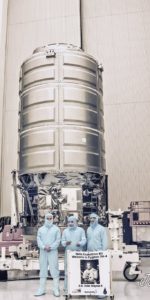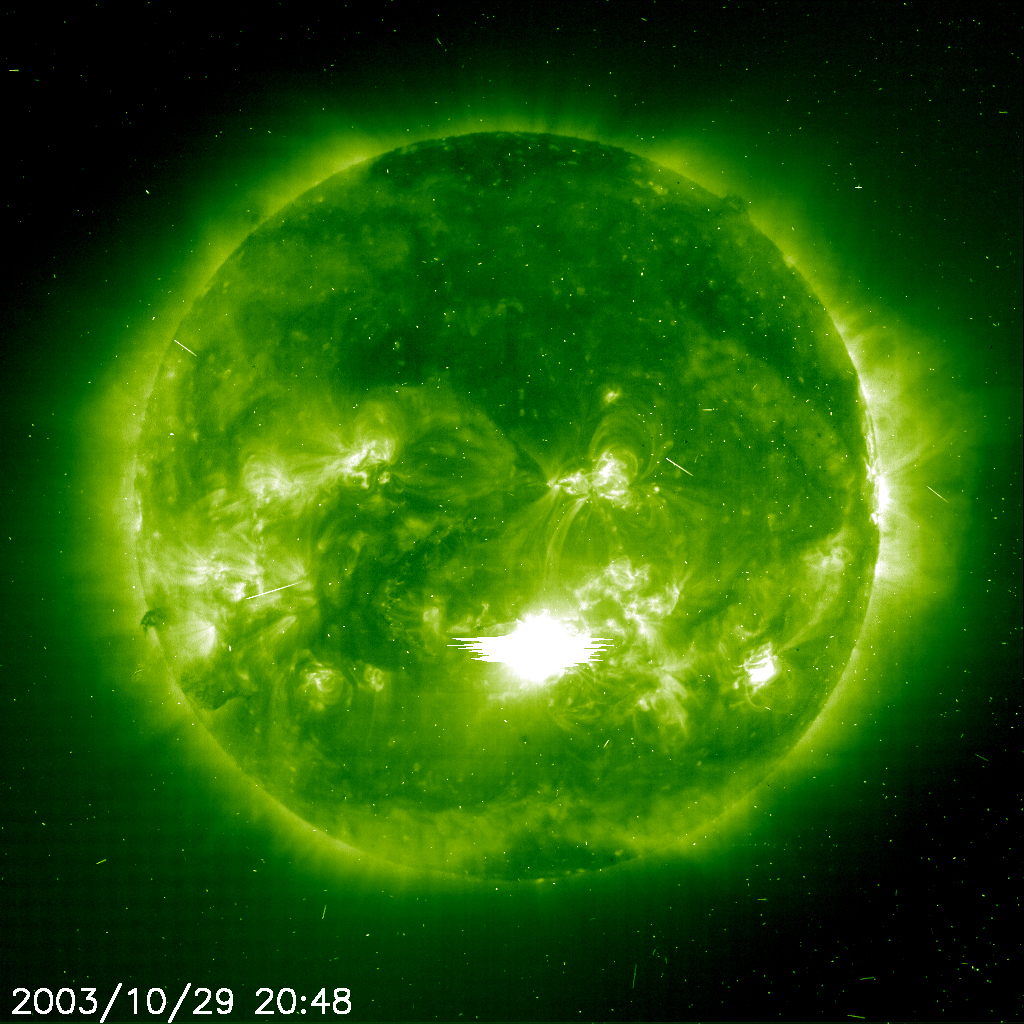
Almost a million miles (1.5 million km) “ahead” of Earth, looping about an elliptical orbit in the vicinity of a gravitational spot in space known as the L1 Lagrange Point, is a spacecraft which has contributed hugely to our burgeoning understanding of the Sun and allowed us to better predict its frequent outbreaks of fearsome wrath. The joint NASA/European Space Agency (ESA) Solar and Heliospheric Observatory (SOHO)—launched two decades ago tomorrow, on 2 December 1995—was originally intended for a 24-month quest to simultaneously explore the solar atmosphere, surface and interior, but proved so successful that it is now midway through its latest mission extension, to December 2016. It is a remarkable accomplishment for a spacecraft which came within a whisker of outright failure, just two years after liftoff.
Built by a European industrial consortium, led by Matra Marconi Space (now EADS Astrium), the 4,080-pound (1,850 kg) SOHO comprises a boxy service module for thermal control, pointing, telecommunications and electrical power—including twin solar arrays, measuring 31.1 feet (9.5 meters) when fully deployed—and a payload module to support a cluster of 12 instruments, three-quarters of which were provided and supported by European Principal Investigators (PIs) and the remainder by U.S.-based PIs. These instruments sought to measure densities and temperatures in the corona, as well as investing its structural evolution and dynamics, together with the ion and electron composition of the anomalous “solar wind” and variations across the Sun’s entire disk as a means of better understanding conditions at the core.
As a concept, SOHO can trace its heritage back to the early 1980s, where it arose from studies into a pair of mission designs, known as the Grazing Incidence Solar Telescope (GRIST) and the Dual Spectral Irradiance and Solar Constant Orbiter (DISCO). According to ESA, it became important because it developed momentum, together with the Cluster mission, as part of the International Solar-Terrestrial Physics Program. In May 1984, ESA identified SOHO as part of the “Cornerstone” of its long-term “Horizon 2000” science program.
In spite of the huge success which it would eventually become, SOHO’s launch on 2 December 1995 was very nearly scrubbed. An initial attempt on 23 November had already been postponed, due to a flaw in a precision regulator aboard the launch vehicle. Mounted atop an Atlas IIAS booster—the most powerful member of the Atlas II rocket family, which achieved a 100-percent success record during its 30 missions between December 1993 and August 2004—the spacecraft was targeted to roar into the night from Space Launch Complex (SLC)-36B at Cape Canaveral Air Force Station, Fla. Then, just 70 seconds before its 2:34 a.m. EST launch time, the countdown was halted, due to an electrical anomaly in the Atlas’ Centaur upper stage. The clock was reset to T-15 minutes, whilst the source of the problem was identified and corrected, and the countdown resumed at 2:53 a.m. Fifteen minutes later, at 3:08 a.m., SOHO departed Earth in a blaze of fire and light, turning night into day across Florida and most of the eastern seaboard of the United States.
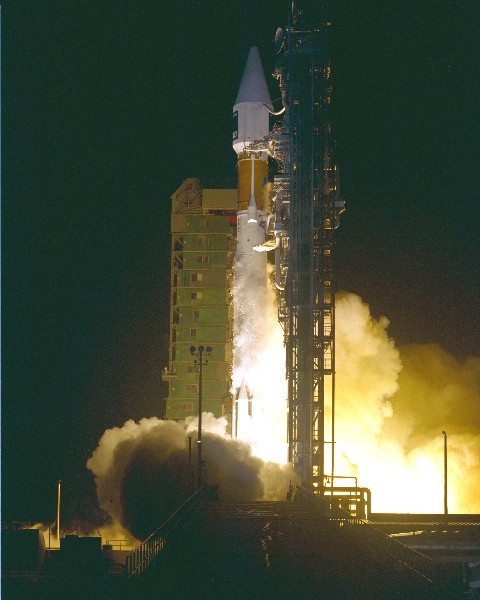
Boosted uphill by the Atlas IIAS’ sustainer engine and side-mounted solid-fueled rocket boosters, the spacecraft was assisted to its science-gathering destination by a pair of “burns” of the liquid hydrogen/oxygen-fueled Centaur, the first of which established it into an “Earth parking orbit” and the second of which delivered it onto a “transfer trajectory” to achieve a halo orbit around the L1 Earth-Sun Lagrange Point. The latter is a position approximately a million miles (1.5 million) “ahead” of Earth, in the sunward direction, at which the gravitational masses of both the Home Planet and our parent star meet in balance, thereby allowing a spacecraft to orbit with them. About two hours after liftoff, SOHO and the Centaur parted company. During its transit to L1, the spacecraft performed an orbit-shaping maneuver in January 1996, and after four months after leaving Earth it successfully entered an elliptical, “Lissajous” orbit close to the L1 point and, after initial checkouts, set to work on an ambitious science program.
For the next two years, through April 1998, the spacecraft returned an astonishing amount of data about our parent star, revealing “rivers” of plasma beneath its surface and a magnetic “carpet” which appeared to be a major contributor to the high temperatures of the corona, as well as acquiring spectacular images of the Sun’s atmosphere and violent Coronal Mass Ejections (CMEs), the latter of which were being used to improve the ability to forecast space weather. Flare-induced solar “quakes”, clashing magnetic field-lines and hot, electrically-charged “tornadoes” were identified, more than 50 “Sun-grazing” comets were discovered and, for the first time, SOHO was able to simultaneously observe the interior and atmosphere of the Sun. In this sense, the spacecraft provided early warnings for solar events which could directly affect Earth and in April 1998—after a spectacular two years of operations, more than two million images taken, around a terabyte of data transmitted and having provided the basis for more than 200 scientific papers—ESA and NASA jointly agreed to extend the mission through 2003. This would enable SOHO to continue observations during the Sun’s most intensive period of activity, known as the “solar maximum”, which was expected to peak in the 2000-2001 timeframe.
Only weeks later, SOHO came within a hair’s breadth of failure.
Late on 24 June, during a series of gyroscope calibrations and maintenance maneuvers, the spacecraft lost its “lock” on the object of its research and entered a mode known as Emergency Sun Reacquisition (ASR). Initial efforts to regain control of SOHO achieved briefly fleeting success, before all contact was lost and the spacecraft was determined to be spinning, losing electrical power and no longer pointing at the Sun. Hurriedly, ESA and Matra Marconi Space personnel were despatched from Europe to NASA’s Goddard Space Flight Center (GSFC) in Greenbelt, Md., to assist the Flight Operations Team with the process of accomplishing a recovery.
A joint investigation board, co-chaired by ESA Inspector-General Massimo Trella and NASA Deputy Associate Administrator for the Office of Safety and Mission Assurance Michael Greenfield, was formed and promptly closed in on three errors which appeared to have been at the root of the communications loss. Two pre-programmed command sequences, issued by ground-based computers, and a subsequent decision to transmit another command in response to unexpected telemetry readings, were suspected to be the root cause. One command had resulted in incorrect readings from one of SOHO’s three gyroscopes, which triggered the ESR mode, whilst another command lacked an instruction to enable the on-board software function necessary to activate a gyro and properly control the spacecraft whilst in ESR mode. This situation was worsened by the decision to command SOHO to turn off a gyro in response to the unexpected telemetry values, which forced the confused spacecraft to enter a series of ESRs and control to be lost.
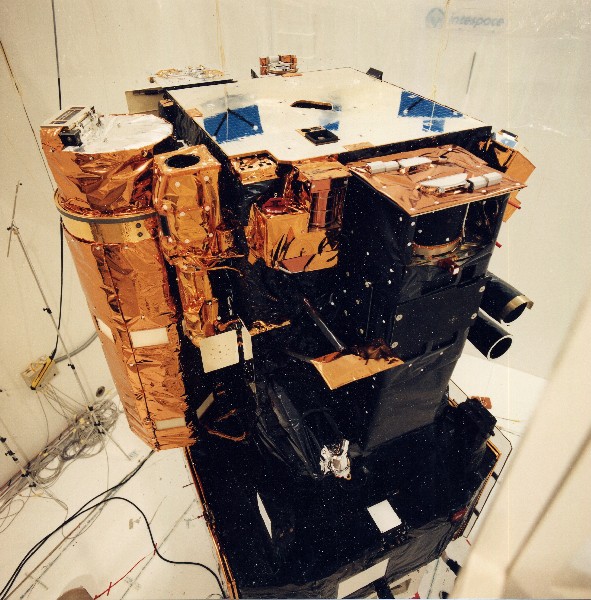
After several weeks of uncertainly, on 23 July, the 990-foot-diameter (305-meter) Arecibo radio telescope in Puerto Rico transmitted a signal, with the 230-foot-diameter (70-meter) dish of NASA’s Deep Space Network (DSN) in Goldstone, Calif., acting as a receiver, and succeeded in locating SOHO, close to its predicted position and rotating at a single revolution per minute. Several days later, the first carrier signal was received from the ailing spacecraft in more than five weeks, with DSN signals from the station in Canberra, Australia, answered by brief bursts of signal, lasting just a few seconds. “Although the signals are intermittent and do not contain any data information,” NASA cautioned, “they show that the spacecraft is still capable of receiving and responding to ground commands.”
More days passed and on 8 August a successful attempt was made to modulate the carrier signal and downlink telemetry, after which efforts to thaw the frozen hydrazine fuel tanks with SOHO’s thermal control heaters got underway. By mid-September, an “Attitude Recovery” maneuver successfully reoriented the spacecraft’s solar arrays towards the Sun, marking its first successful commanding from the ground since the 24 June failure. Described as “a big step forward in our recovery plan” by ESA Head of Scientific Projects John Credland, this event was followed by the critical process of bringing the 12-strong instrument payload back to life. “Despite the gloomy early days after the loss, we always stayed hopeful that the resourceful people on the team could save the day,” said George Withbroe, director of the Sun-Earth Connection science theme at NASA Headquarters in Washington, D.C. “We’re not there yet. We still have to see if the scientific instruments survived.”
Step by critical step, and instrument by critical instrument, SOHO’s spacecraft “bus” was nursed back to normal operations by 25 September and the science payload came gradually back to life after almost three months subjected to the wide extremes of frigid cold and furnace heat. The first instrument which came back online, on 5 October, was the Solar Ultraviolet Measurements of Emitted Radiation (SUMER), a combined telescope and spectrometer, provided by Germany’s Max Planck Institute. The last was the Charge, Element and Isotope Analysis System (CELIAS), supplied by Switzerland’s University of Bern, which returned to normality on 24 October.
However, the recovery left only a single gyro still fully operational and, on 21 December 1998, it too failed. This obliged ESA and Matra Marconi Space controllers to adopt a new attitude-control approach, performing manual thruster firings which consumed about 15.4 pounds (7 kg) of on-board hydrazine propellant each week, a potentially life-limiting situation for SOHO. However, ESA engineers were already at work devising a new “gyroless” operations mode, which came online on 2 February 1999 and has sustained it ever since. “The satellite is now reprogrammed to ignore faulty information from the gyroscopes and to use new software sent up by ground controllers,” ESA explained. “This is the first time that a spacecraft equipped with gyroscopes has carried on working without them.” That is not to say that technical glitches have not materialized from time to time. In June 2003, for example, a malfunction in the pointing mechanism of SOHO’s high-gain antenna forced an interruption of data-gathering capability for a few weeks. Control of the spacecraft was maintained throughout this period by its omni-directional low-gain antenna.
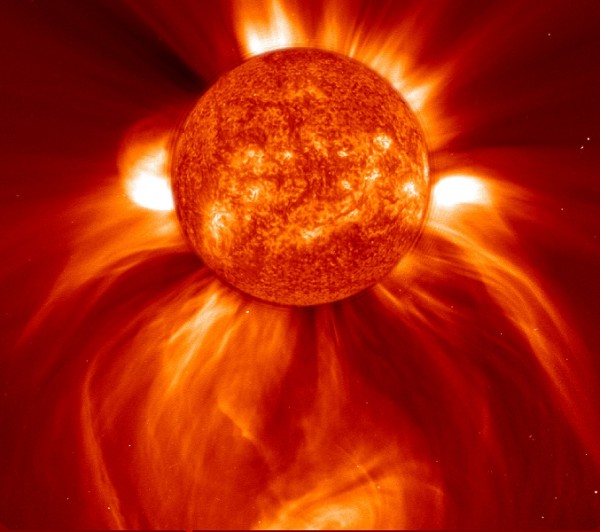
Notwithstanding these troubles, its accomplishments have been nothing short of remarkable. In June 1999, data from the spacecraft’s French-built Solar Wind Anisotropies (SWAN) instrument enabled new techniques for studying the Sun’s hidden far side, thereby allowing for predictions of the imminent appearance of potentially Earth-threatening storms. This capability was further extended by Stanford University’s Michelson Doppler Imager (MDI), which employed the technique of using ripples on the solar surface to probe the interior as a tool to image major storms brewing in active regions on the far side. In July 1999, SOHO data—examined in tandem with results from the shuttle-borne Spartan-201 spacecraft—revealed that the enigmatic, million-mile-per-hour (1.6 million km/h) solar wind streamed from our parent star by “surfing” waves in its atmosphere.
Due to its clear and unobstructed view of the Sun, SOHO has confirmed the identification by ground-based astronomers of no fewer than 3,000 comets, the most recent of which was found on 14 September 2015. Two years ago, it also monitored the final hours and eventual disintegration of Comet ISON. This was not originally part of its assigned mission, but by early 2000 the spacecraft’s ability to spot “Sun-grazers”—so called because of their close approach paths to our star—had already secured it the accolade for having found over a hundred discrete comets. Even at this early stage, SOHO was the most successful comet-hunter in history, its observations enabled primarily by the U.S. Naval Research Laboratory’s Large Angle and Spectrometric Coronagraph (LASCO) instrument. It passed its 500th comet discovery in August 2002 and its 1,000th in August 2005. “Before SOHO was launched, 16 Sun-grazing comets had been discovered by space observatories,” noted Chris St. Cyr of NASA-Goddard. “Based on that experience, who could have predicted that SOHO would discover more than 60 times that number, and in only nine years? This is truly a remarkable achievement.” Yet that achievement was far from over, for SOHO hit 1,500 comets in June 2008 and 2,000 in December 2010, setting it in pole position to double this number by the fall of 2015, creating an average of one confirmed comet every 2.6 days.
As Earth’s primary sentinel to watch out for brewing solar storms, in June 2000 observations from SOHO allowed for the development of better theoretical models to predict how long Coronal Mass Ejections (CMEs) would take to travel the distance from the Sun to our planet, based upon how their initial velocity was sped up or slowed by the influence of the solar wind. And by December of that same year, as the period of solar maximum neared, SOHO’s Extreme Ultraviolet Imaging Telescope (EIT)—provided by NASA’s Goddard Space Flight Center—had trialed the capability to accurately forecast solar flares and predict major geomagnetic storms, whose fury threatened to disable cameras and star-trackers on several Earth-circling satellites, produce vivid auroral displays, disrupt power supplies and degrade Global Positioning System (GPS) accuracy.
This was followed, early in 2001, by the detection of one of the strongest solar flares in 25 years of accurate monitoring. The flare originated from Active Region (AR) 9393 and, although not directed specifically towards Earth, its wrath caused significant radio disruption on Earth. Throughout its long mission, SOHO has focused upon the role of sunspots—dark-hued and relatively cool concentrations of magnetic field flux—and in the spring of 2001 it identified one such object in AR 9393 which was 13 times larger than Earth’s surface area. In fact, this particular sunspot was the largest of its kind to be detected in more than a decade. Subsequent MDI data revealed that, in spite of their vast size, sunspots are surprisingly shallow and lie atop swirling hurricanes of electrified gas. Sunspot 484, identified by SOHO in October 2003, was the size of Jupiter, the largest planet in the Solar System. By the tenth anniversary of its launch, in December 2005, SOHO was being lauded with having provided space weather forecasters with the ability to predict Earth-directed disturbances with up to three days’ advance notice.
Already extended through to 2003, yet another mission extension was granted, allowing the spacecraft to continue its observations until at least March 2007, thereby covering an entire, 11-year solar cycle, including the “solar minimum” phase of relatively reduced activity. Now, in December 2015, as it enters the final 12 months of its latest mission extension, SOHO is one of only four spacecraft to have occupied the L1 Lagrange Point. The others are the International Sun-Earth Explorer (ISEE)-3—which left Earth in August 1978 and in mid-November became the first human-made machine to occupy a halo orbit around L1—together with NASA’s 1994-launched Wind spacecraft, the 1997-launched Advanced Composition Explorer (ACE) and, most recently, the Deep Space Climate Observatory (DSCOVR). The latter was launched in February 2015 and, after a four-month trek out to L1, was on-station by 8 June.
Twenty years since its launch, SOHO has revolutionized our understanding of the interior, atmosphere and surface of the star which is, quite literally, the reason for our existence. On a pragmatic level, its data has allowed significant advances in the prediction of solar storms and CMEs, which is of crucial importance not only for we Earth-dwellers, but also for human explorers who eventually return to the Moon and out into the Solar System. By 2005, it was already possible to achieve three-day warnings, but earlier in 2015 theoretical modeling enabled through SOHO results was underway to predict CMEs’ magnetic configurations from afar, possibly allowing utility grid and satellite operators a full, 24-hour advance warning mechanism to protect their assets.
Want to keep up-to-date with all things space? Be sure to “Like” AmericaSpace on Facebook and follow us on Twitter: @AmericaSpace
Missions » DSCOVR »



